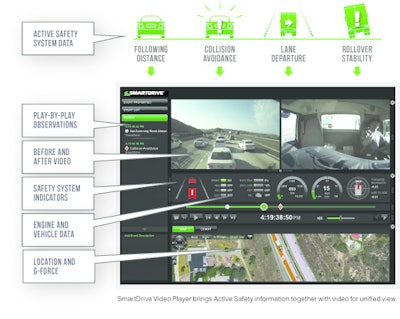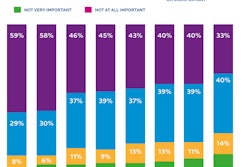
Keeping an Eye on the Transportation Safety Ball
It wouldn’t surprise most people to see or hear about a collision involving a tractor trailer on the evening news or in the morning paper. Mile after mile, hour after hour, commercial drivers are subject to risks, many of which are not a reflection of their own skills, which were honed over years of professional driving. Whether as a result of the actions of other drivers on the road, equipment failures or other causes, there is no shortage of factors that lead to collisions. These incidents can endanger lives, impact brand perceptions, take time away from business, incur costs and disrupt the supply chain.
Unlike traditional desk jobs in which a supervisor can check in with employees face to face on a daily basis, fleet managers don’t generally have real-time visibility into their drivers’ performance and actions on the road. As a result, the back-office staff has limited ability to quickly address driving performance and safety compliance issues, or provide effective coaching to correct skills that contribute to increased risk. Without insight into these matters, proactive intervention and performance improvement are difficult, if not impossible.
Austin, Texas-based LSO, a regional parcel carrier founded in 1991, realized that it had a limited view of risk, which compromised its total picture of fleet safety. As a result, LSO sought a solution that provided more complete insight to risk and operational performance to complement its existing safety program, and drive continuous improvement.
Enter In-Cab Video Technology
With video-based safety technology, LSO found what it was looking for and more. Having considered a variety of tools to help improve fleet-wide safety, LSO zeroed in on a provider of driving performance solutions designed to reduce collisions and improve fuel efficiency through the use of video analytics. Tangible, measurable results—including a 47 percent improvement in the fleet’s safety score—soon followed.
“There are countless distractions faced by today’s driver and we knew that adding video to our safety program would have a meaningful impact on our fleet,” said Steve Hendon, safety and compliance manager at LSO. “In addition to being easy to use, SmartDrive’s video-based safety program helps us identify and address high-risk indicators like cell phone usage, driver fatigue, rolling stops and seatbelt compliance. With this information, we are able to quickly and productively engage drivers on areas for improvement, and measure the results with easy-to-understand, easy-to-act-on key performance metrics.”
While many are familiar with the use of video as a tool to improve security and visibility, and its solid record of success in improving safety and operational efficiency in other industries, the use of video in commercial transportation is in the early stages of adoption. In-cab and outward-facing cameras—coupled with rich insights delivered by providers with a breadth and depth of data and risk analysis that spans many years, hundreds of fleets and thousands of drivers—offer a clear view into a portion of fleet operations that was hidden from fleet owners and managers. Driver- and road-facing cameras allow operations and safety staff to proactively develop coaching for unsafe driver skills and risky habits.
Video footage, automated incident risk scoring and coaching tools combine to give fleet managers a unique view to what’s happening in the cab and around the vehicle, resources to help strengthen communication with drivers, and metrics to assess individual and company-wide performance against fleet-configurable metrics.
Real Results Right from the Start
LSO adopted a video-based safety program as part of a broader effort to build on its commitment to enhance the company’s safety program. In addition to promoting safe driving, LSO also turned to video technology to identify performance improvement opportunities and mitigate risk.
The platform LSO implemented identifies the high-risk driving that leads to collisions with an open platform that captures video, vehicle, audio and driving data. This footage is automatically offloaded for expert review and analysis, providing a clear picture of what is happening on the road, and is prioritized for action by the fleet. LSO references video footage during driver training sessions to address issues and recognize drivers that demonstrate good driving skills. After LSO deployed the video-based program at one of its sites, the fleet was able to lower the risks that are key leading indicators of collisions—seatbelt compliance improved by 100 percent, while mobile phone usage and texting were reduced by 90 and 69 percent, respectively. Excessive speeding incidents were cut in half, while incomplete stops were lowered by 82 percent and unsafe following decreased by 77 percent.
“At LSO, we are committed to industry-leading customer service, and proud to have one of the highest shipping reliability records and lowest damage rates in the industry,” continued Hendon. “Our focus on safety demonstrates that investment in video has a positive return on investment. The solution’s powerful combination of real-time video capture, delivery of results and insights faster than any other offering, and predictive analytics enabled us to reduce collisions and materially reduce risk.”
LSO drivers embraced the benefits of video-based technology. The system helped identify driver fatigue issues, capturing risky nighttime driving, and providing video for further coaching and training. In addition, video provides insight into driver and vehicle behavior in response to calls reported via the company’s 1-800 line. In instances in which a collision occurs, the video also provides visual proof of what happened prior to the event and serves as a reliable tool to exonerate drivers from faulty claims.
In two recent instances, LSO used video to exonerate its drivers. One incident involved a collision with a bicycle, which would typically result in immediate termination of the driver if he was at fault. The footage captured with the video-based safety program proved that the driver was not at fault, saving his job. The second incident involved a collision in which a mechanic was returning a van to the shop. When another driver turned left coming out of a side road, a collision resulted. Again, thanks to the availability of video, the mechanic was exonerated.
Hendon noted: “It feels good when you can go back to the driver and showcase the information that the SmartDrive video-based program is providing on their behalf. It also gives us an opportunity to thank him or her for handling the job professionally. While our drivers were initially reluctant to embrace in-cab video, they quickly saw the benefits and jumped on board.”
Video-based solutions designed for transportation give fleets and drivers unprecedented driving performance insight and analysis, helping improve safety and save fuel, expenses and lives. Video analysis, predictive analytics and personalized performance programs help fleets progress driving skills, lower operating costs and deliver significant ROI. Delivered as an easy-to-use managed service, fleets and drivers can access and self-manage driving performance anytime, anywhere.
“We’re confident we made the right decision in choosing to incorporate this technology into our comprehensive safety program,” added Hendon. “For fleets that are on the fence or may not have considered the merits of video-based programs, we would strongly recommend they move forward. This technology is game-changing.”















